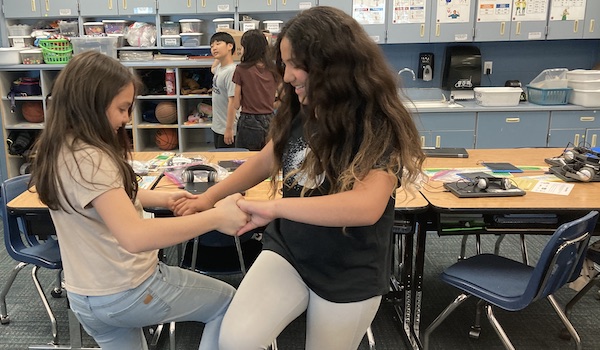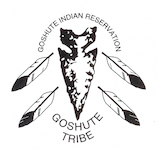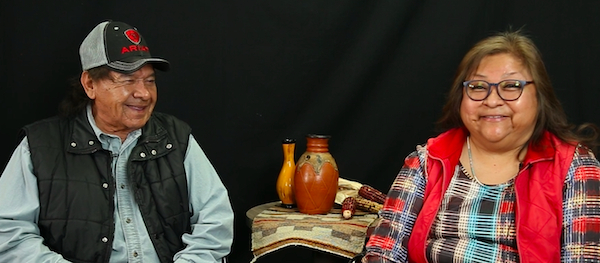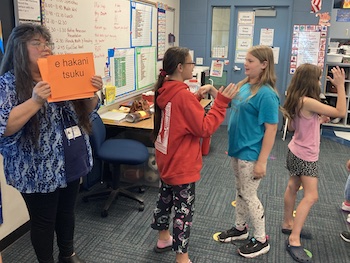SUBJECTS
GRADE
Show Results
Hello, e hakani: Goshute Greetings

Lesson Summary
- Create partner handshakes and group movement sequences.
- Learn several greetings in the Goshute language.
Lesson Plan and Procedure
Lesson Key Facts
- Grade(s): 3, 4, 5, 6
- Subject(s): Dance, English Language Arts, Health, Social Studies, Native American, Tribe Approved
- Duration of lesson: 45-60 minutes
- Author(s): Clell and Charlene Pete (CTGR), Yvette Ward May, Emily Soderborg

The Confederated Tribes of the Goshute selected this lesson content in answer to the question, “What would you like the students of Utah to know about you?” One of their responses was their concern for the preservation of their Goshute language and dialects. Some of the rising CTGR generation know very little of their ancestral language, which communicates much of their traditional culture and way of life. Efforts are being made to teach the language to the students in Ibapah schools. This lesson is meant to support, raise awareness, and include the arts (creative movement) with Core Standards. It is written to reinforce retention and preservation of some Goshute greetings. Charlene and Clell Pete, represented the CTGR in crafting the lesson to provide expertise, accuracy, and authenticity.
Before teaching this lesson, please explain to your students that there are many Indigenous tribes in the United States and that this lesson specifically focuses on the Confederated Tribes of the Goshute, and does not represent other Native American groups. It is the hope of the CTGR that other native tribes will respect their choice to share these aspects of their history and culture.
Note to the Teacher: The Goshute language was not a written language. It was passed from generation to generation through oral tradition. The language has been transcribed by linguists, people who study languages, which means the spellings are different, based on the style used by each linguist. The greetings in this lesson can be difficult to read. Students will be able to hear and practice proper Goshute pronunciation with the lesson videos featuring Clell and Charlene Pete. Focus more on listening and speaking the greetings, rather than reading them.
Lesson:
- Upload Lesson Slideshow: Goshute Greetings
Slide 1: Title page
Give a few exaggerated, full-body, formal greetings to the class, followed by a couple greetings using different English-speaking accents (southern, western, eastern, Scottish, Irish, Spanish, French, British, Australian, etc.)
Slide 2: Depending on who we’re talking to, where we’re from, and in what situation, we all greet each other in different ways.
Slide 3: Dialect
Teacher: For example, when we greet each other, some of us may often say “Hi!”, others, “Hello, How’s it goin’?”, “Was’sup?”, “Howdy”, or “Hi, y’all!”
Select from the following options and write student responses on the whiteboard.
Teacher: What would you say? How would you greet?
- Your best friend?
- Your teacher?
- A new baby?
- The librarian?
- Your Grandma or Grandpa?
- Someone you know who’s on the opposite side of a big soccer field?
- Your pet dog or cat?
- Someone who is grumpy?
- Someone famous, who you really admire?
- When you answer an unknown caller on the phone?
- Someone you haven’t seen in a long time?
Teacher: What if you used your body, rather than your words in greeting? What would that be like? Watch how this teacher greets each of his students every day with a personalized handshake.
Slide 4: If needed, upload the video ahead, from this link: Teacher Has Personalized Handshakes With Every Single One of His Students (1:03)
Partner Movement Activity:
Teacher: Now, it’s your turn. Listen carefully and silently read-along, as we go through the instructions together.
Slide 5: Partner handshake instructions
Set a timer for 3 minutes.
Teacher: Begin!

When the timer ends, invite children to freeze in place. Split the room in two equal groups, with an imaginary line. Designate one side of the class as group 1 and the other as group 2.
Group 1 will share their handshake routines all at the same time while group 2 watches. Then Group 2 will share their handshakes, while Group 1 watches.
Teacher: As you’re being an audience, watch the other partners carefully. Look for creative movements and greetings that catch your attention. What did you really like?
Group 1 students share their handshake routines.
Teacher: Audience, what creative movements and greetings caught your attention? What did you really like? (responses will vary)
Group 2 students share their handshake routines.
Teacher: Audience, what creative movements and greetings caught your attention? What did you really like? (responses will vary)
Recognize and express specific appreciation for individual student efforts, creativity, and participation.
Teacher: Are there languages, other than English, spoken in your home? What are they? (Answers will vary) Do you speak and understand that language? Where did that language come from? By learning and speaking that language, you are preserving it.
Slide 6: How is language lost?
Slide 7: C.T.G.R. is making the effort to preserve their language.

Slide 8: Introducing Clell and Charlene Pete
Teacher: The formation of the CTGR reservation brought together Goshute, Ute, Paiute, Navajo, and Shoshone families and tribal groups. That is why they are called the “Confederated Tribes” of the Goshute. Each brought their own language and dialect, though their original Numic language was similar (to all, but the Navajo). As we watch the following video, think about how their language evolved as these family and tribal groups were brought together. Why is it important to learn the language(s) spoken in your family?
Slide 9: VIDEO Where Dialects are From & How they teach language (2:11)
Teacher: How did the language and dialect change as these family and tribal groups were brought together? Why is it important to learn the languages spoken in your family?
The Goshute language and dialects help to preserve their ancestral culture and enduring connections.
We have the opportunity of learning some of the CTGR greetings. We will speak and create movement for these greetings. We’ll begin with their common greeting. See if you can hear any differences in dialect between Clell and Charlene.
Slide 10: VIDEO “e hakani” How to greet in Goshute & pronunciation practice (1:33)
*Pronunciation: Often in the Goshute language the letter “k” is more a combination of a g and a k, spoken together in sequence. Ex: hakani = e hagkani
Teacher: Did you notice the subtle difference between the dialects of Charlene and Clell, as they each said “e hakani?” How were they different?
Invite the children to repeat “e hakani” aloud 3 times.
Teacher: How could we use our bodies to express “e hakani”?

Activity 1: Model two or three ways that students could apply B.E.S.T. to communicate “e hakani” through movement. Have them choose from the options you demonstrate, and invite the whole class to do the chosen movement and say “e hakani” together. (Practice 3 times)
Teacher: Watch and listen again as Charlene Pete shares a fun story about how she used another friendly Goshute greeting.
Slide 11: VIDEO "e hakani haintseh" (1:57)
Say “e hakani haintseh” together (practice 3 times), as if saying hello to a cute little animal, like the burrowing owl.
Slide 12: B.E.S.T. (basic elements of dance and movement)
Activity 2: Teacher-guided: Students will work together to design this “e hakani haintseh” greeting movement.
Invite 4 volunteers to come to the front of the class.
Using B.E.S.T, assign each volunteer a letter. (B-body, E-energy, S-space, T-time) Each will select, create, and demonstrate what kind of movement they want to create for this greeting.
Combine their B.E.S.T. choices into the greeting-movement.
Invite the whole class to say “e hakani haintseh” and do the movement together, three times.
Teacher: Since you are well-familiar with the B.E.S.T. elements of movement and dance. Now you have the opportunity to work with your partner again to create a Goshute greeting handshake.
Activity 3: Partner created handshake
Upload: Student: Goshute Greetings and share the link with all students.
Slide 13: Goshute greeting, partner handshake instructions
Students take turns sharing and watching each other.
Teacher: What creative movements and greetings caught your attention? What did you really like? (responses will vary)
Recognize and express specific appreciation for individual student efforts, creativity, and participation.
Concluding Activity Options:

- Option 1: Play a memory-movement game, using these Goshute Greeting signs. When you show a sign, students will immediately say the greeting and do the associated movement or handshake. They freeze and watch others, when there’s a greeting they did not learn.
- Invite students to stand beside their partner.
- Make sure every child can see you.
- Shuffle the order, and speed up or slow down the tempo, as you display the different signs.
- Option 2: Invite students to form a big class circle, standing beside their partners, with everyone facing each other. Go around the circle and invite each child to share their favorite Goshute greeting, movement, or partner handshake.
Reflections:
- What have you learned about preserving language?
- What have you learned about the (CTGR) that you didn’t know before?
- What are some ways we can preserve language?
- What are some things you learned about yourself today?
- What did you like about this experience today?
Learning Objectives
- Listen to other’s ideas and cooperate when creating dance.
- Identify ideas for choreography and solve movement problems.
- Develop a dance study that expresses a main idea.
- Establish spatial relationships with other dancers while safely using levels, directions, focus, and pathway designs in near-, mid-, and far-range movement.
- Make still and moving shapes with positive and negative space.
- Demonstrate fundamental dance skills through locomotor and non-locomotor sequences.
- Recall and replicate movement sequences with a partner or in group dance activities.
- Use performance etiquette and performance practices during class, rehearsal, and in formal and informal performance spaces.
- Demonstrate ways to express gratitude and treat others with dignity and respect.
- Summarize information presented in various formats and media and explain how the information pertains to the topic.
- Participate effectively in a range of conversations and collaborations, using age-appropriate vocabulary, on topics, texts, and issues.
- Respectfully acknowledge and respond to comments and claims.
- Participate in conversations by asking questions, acknowledging new information, connecting responses with reasoning and elaboration, and keeping the discussion on topic.
- After studying examples of individuals or groups making positive changes in Utah, propose positive steps individual students or groups of students can implement (for example, raising awareness of language preservation).
- Combine locomotor skills and movement concepts (e.g., levels, shapes, extensions, pathways, force, time, and flow) to create and perform a dance or rhythmic activity with a partner.
- Use B.E.S.T. (Body, Energy, Space, Time) to create movement routines.
- Use various motor skills in a variety of small group practice tasks.
- Exhibit responsible behavior in independent group situations.
Utah State Board of Education Standards
This lesson can be used to meet standards in many grades and subject areas. We will highlight one grade’s standards to give an example of application.
DANCE: Grade 4
- Standard 4.D.CR.1: Demonstrate willingness to listen to others' ideas and cooperate when creating dance.
- Standard 4.D.CR.2: Identify ideas for choreography generated from a variety of stimuli to solve given movement problems.
- Standard 4.D.CR.3: Develop a dance study, alone or with others, that expresses and communicates a main idea.
- Standard 4.D.P.1: Establish spatial relationships with other dancers while safely using levels, directions, focus, and pathway designs in near-, mid-, and far-range movement.
- Standard 4.D.P.2: Make still and moving shapes with positive and negative space.
- Standard 4.D.P.4: Demonstrate fundamental dance skills through locomotor and non-locomotor sequences.
- Standard 4.D.P.7: Recall and replicate movement sequences with a partner or in group dance activities.
- Standard 4.D.P.9: Use performance etiquette and performance practices during class, rehearsal, and in formal and informal performance spaces.
HEALTH: Grade 4
- Standard 5.HF.4: Demonstrate ways to express gratitude and treat others with dignity and respect.
ELA Grade 4
- Standard 4.SL.2: Clearly summarize information presented in various formats and media and explain how the information pertains to the topic.
- Standard 4.SL.1: Participate effectively in a range of conversations and collaborations, using age-appropriate vocabulary, on topics, texts, and issues.
- Respectfully acknowledge and respond to comments and claims.
- Participate in conversations by asking questions, acknowledging new information, connecting responses with reasoning and elaboration, and keeping the discussion on topic.
SOCIAL STUDIES Grade 4
- Standard 4.5.5: After studying examples of individuals or groups making positive changes in Utah, propose positive steps individual students or groups of students can implement (for example, raising awareness through digital media, energy and resource conservation, letter writing, fundraising).
PHYSICAL EDUCATION Grade 4
- Standard 4.1.4: Combine locomotor skills and movement concepts (e.g., levels, shapes, extensions, pathways, force, time, and flow) to create and perform a dance or rhythmic activity with a partner.
- Standard 4.1.6: Use various motor skills in a variety of small group practice tasks.
- Standard 4.4.1: Exhibit responsible behavior in independent group situations.
Equipment and Materials Needed
- Upload Lesson Slideshow: Goshute Greetings
- Upload Student: Goshute Greetings and share the link with all students
- Whiteboard and marker
- Large screen for sharing slideshow and videos
- Student I-pads, Chromebooks, etc. (for viewing Student Goshute Greeting videos)
- Make one copy of Goshute Greeting signs
- Timer
- Familiarize yourself with the following vocabulary:
- Reservation: an area of land set aside for occupation by North American Indians.
- Dialect: A dialect is a form of a language spoken by a group of people.
- Sovereign nation: Tribal sovereignty in the United States is the concept of the inherent authority of Indigenous tribes to govern themselves within the borders of the United States. There are eight sovereign nations in Utah. They are:
- The Confederated Tribes of the Goshute Reservation
- The Skull Valley Goshute
- The Ute Indian Tribe of the Uintah and Ouray Reservation
- The White Mesa Community of Ute Mountain Ute
- The Navajo Nation
- The Northwestern Band of the Shoshone
- The Paiute Indian Tribe of Utah
- The San Juan Southern Paiute
Additional Resources
This lesson was created thanks to a grant from the National Endowment for the Arts and the Utah Division of Arts & Museums
- https://advancingartsleadership.com/node/5#danceelements
- Clell and Charlene Pete: Goshute Greetings Rough-cut Video
- Playlist of Goshute Greetings: https://www.youtube.com/playlist?list=PLMgS4EBwZnV8lafES6I5dwZkSaml3uwM2
Image References
Image 1: Emily Soderborg
Image 2: Confederated Tribes of the Goshute Reservation
Image 3: Emily Soderborg
Image 4: James Huston
Images 5-6: Emily Soderborg
© Brigham Young University and the Confederated Tribes of the Goshute Reservation

www.education.byu.edu/arts/lessons
 Download
Download